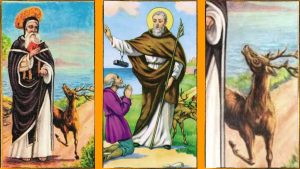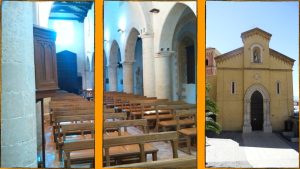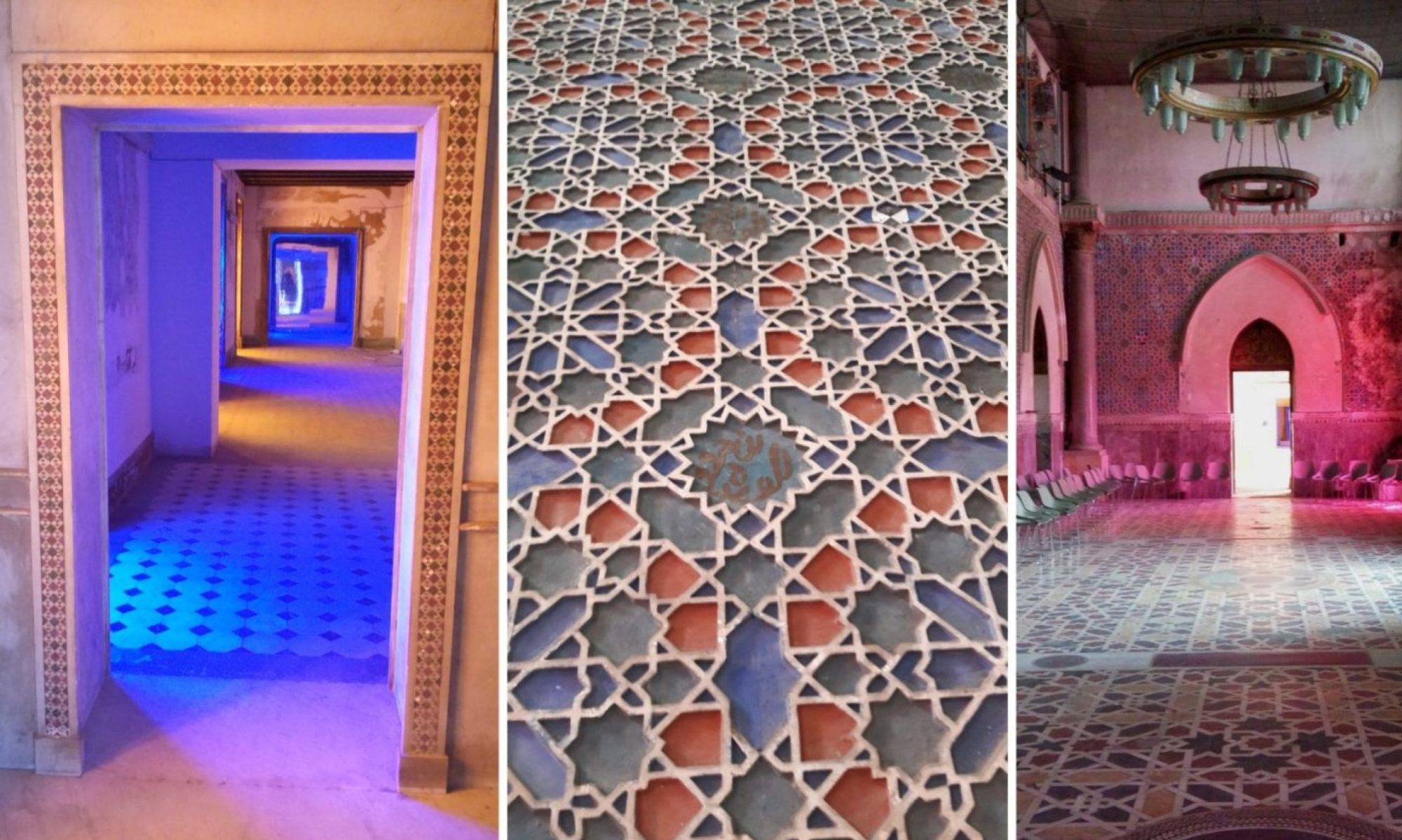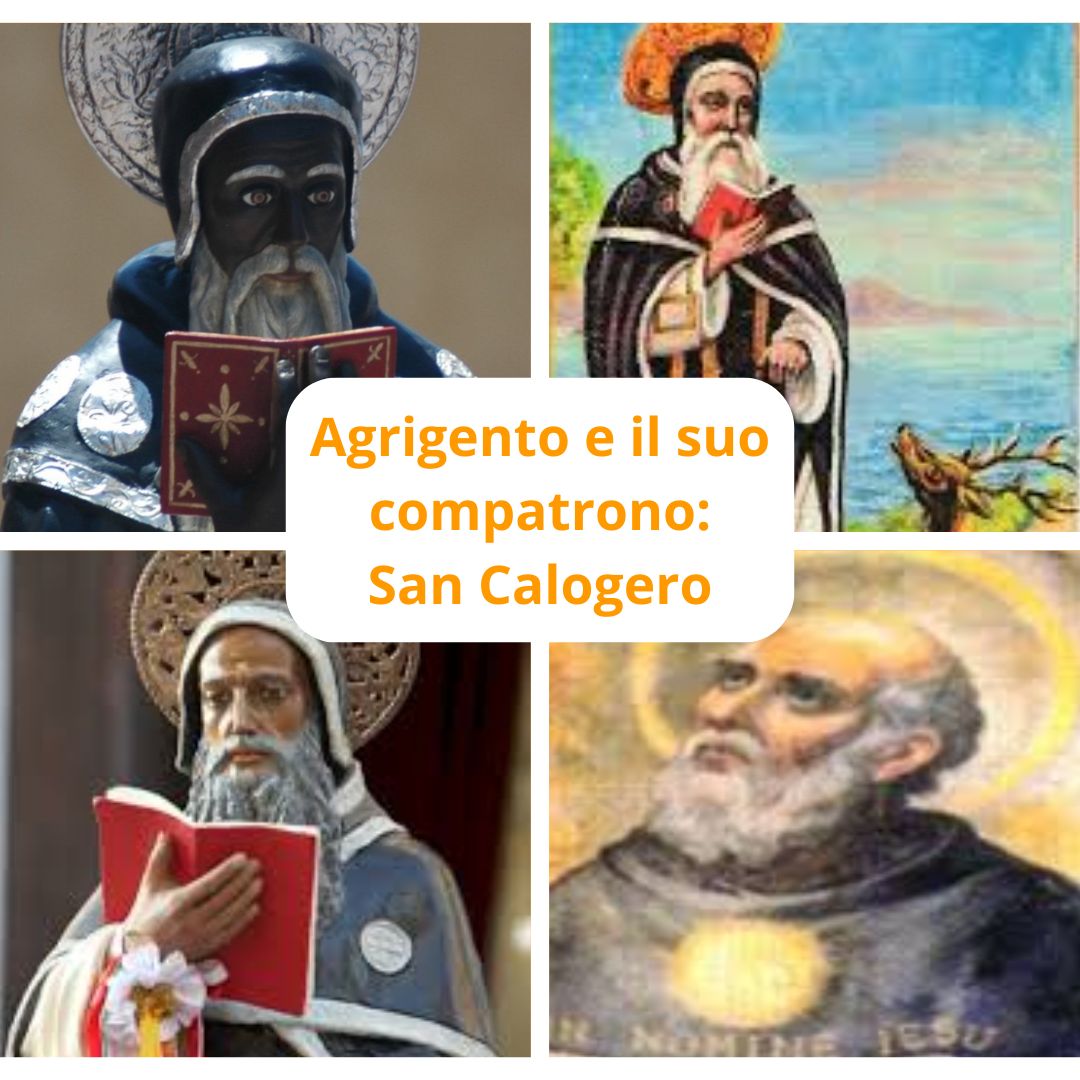[:it]Agrigento e San Calogero un connubbio molto interessante. San Calogero è un santo venerato principalmente nella Chiesa cattolica e nella Chiesa ortodossa così come è particolarmente benvenuto in Sicilia, dove è considerato il patrono di alcuni comuni dell’isola: è il patrono di Naro (AG) e compatrono di Agrigento. I suoi fedeli a lui si rivolgono come “San Calòjiru” o “San Caloriu”.
Agiografia di San Calogero
Calogero, nato a Calcedonia nel 466, è stato un monaco eremita, venerato come santo taumaturgo dalla chiesa cattolica e da quella ortodossa, e patrono di diverse località della Sicilia. Calogero nacque da genitori cristiani e sin da piccolo abbracciò gli insegnamenti del cristianesimo.
Le informazioni storiche su San Calogero sono avvolte nel mito e nella leggenda, di conseguenza scarse e gran parte di ciò che si conosce è tramandato attraverso la tradizione orale.
Un breviario siculo-gallicano, in uso nella regione tra il XI secolo e il XVI secolo lo fa nativo di Costantinopoli; lo descrive come pellegrino a Roma dove Calogero incontrò San Pietro apostolo da cui ottenne il permesso di vivere da eremita in un luogo imprecisato… qui ebbe l’ispirazione di evangelizzare la Sicilia. Tornato dal Primo Papa, ottenne il permesso di recarsi nell’isola assieme ai compagni, Filippo, Onofrio (distinto dall’omonimo eremita) e Archileone.

Filippo si recò a Agira, Onofrio e Archileone si recarono nell’area di Sutera e Calogero si fermò a Lipari.
Altre leggende, invece, spostano la sua esistenza tra V e VI secolo. A vent’anni, secondo l’innografia composta dal monaco Sergio, fuggì dalla Tracia a causa delle persecuzioni scatenate dai monofisisti contro i fedeli al dogma proclamato nel 451 nel concilio di Calcedonia.
Si recò in Sicilia, dove si trattenne per qualche tempo predicando e prestando cure agli ammalati usando l’acqua sulfurea proveniente da una sorgente vicino alla sua grotta, convertendo molti abitanti e proseguendo nella sua vita di eremita e taumaturgo.
Oltre alla sua fama di guaritore delle malattie della pelle, San Calogero è associato a diversi miracoli, secondo le leggende locali, come la moltiplicazione del cibo per sfamare i poveri e la liberazione di prigionieri ingiustamente condannati.
Secondo la leggenda riportata nei Dialoghi di Papa Gregorio I, a Lipari avrebbe avuto la visione dell’anima del re Teoderico gettata nel cratere dell’isola di Vulcano il giorno stesso della morte di quest’ultimo (30 agosto 526). Da qui, dopo diversi anni, si spostò nei pressi di Sciacca dove visse per trentacinque anni.
Calogero sbarcò a Lilibeo, dove Gregorio e Demetrio furono martirizzati da idolatri; a questo proposito vi sono due diverse teorie intorno all’identità degli uccisori.
Parte della storiografia ritiene che il Vescovo di Lilibeo fosse in realtà un monofisista, visti gli intensi scambi commerciali intercorrenti tra la Sicilia e i patriarcati di Antiochia e Alessandria, territori ove il monofisismo era molto radicato, e come tale abbia giustiziato quelli che considerava due eretici.
Altri storici ritengono che siano invece caduti nelle mani dei Vandali, fanatici ariani che, in quegli anni, imperversarono in Sicilia e nel Nord Africa.

Scampato alla morte, iniziò a vagabondare per l’isola, nascondendosi in antiche necropoli e nelle numerose grotte di origine vulcanica sparse per la Sicilia. Partendo da queste peregrinava per i paesi ove predicava la fede, amministrava i sacramenti e assisteva gli ammalati.
Ultima sua tappa furono le grotte poste sul monte Kronos (Kronio) presso Sciacca; qui visse operando molti miracoli e guarigioni e convertendo molti abitanti alla fede cristiana. Morì a Monte Kronio nella notte tra il 17 e il 18 giugno del 561 all’età di 95 anni.
Altre leggende devozionali
Tradizioni agiografiche raccontano che durante la sua vecchiaia, non potendo più raccogliere le erbe di cui nutrirsi, si cibava del latte di una cerva che gli sarebbe stata mandata da Dio. Un giorno però il cacciatore Siero, detto Arcario perché cacciava con l’arco e le frecce, uccise involontariamente l’animale.
Addolorato per aver compiuto tale errore, divenne discepolo del santo. Alla morte di quest’ultimo, avvenuta dopo quaranta giorni, lo stesso Arcario lo seppellì in una caverna sul monte, nota a lui soltanto. Egli trasformò successivamente la grotta in cui era vissuto Calogero in una piccola chiesa, dove alloggiò insieme ad altri discepoli. In seguito, vennero scavate nella roccia le cellette che costituirono i dormitori: furono dette “Eremo” o “Quarto degli Eremi“.
A causa delle invasioni Saracene in Sicilia, il vescovo agrigentino del tempo per non far disperdere le reliquie le fece condurre nel messinese presso il monastero basiliano di San Filippo di Fragalà, nei pressi di Frazzanò. Ai giorni nostri le sacre spoglie riposano in una cassa lignea nella chiesa madre di Frazzanò, Diocesi di Patti, assieme a quelle del patrono e concittadino della città San Lorenzo.

Feste e tradizioni
Ad Agrigento
Il Patrono di Agrigento è San Gerlando ma i festeggiamenti maggiori sono tributati a San Calogero, che è il compatrono. Durante gli otto giorni di festa, dalla prima alla seconda domenica di luglio, si intersecano misticismo, antiche tradizioni, leggende e profonda fede cristiana. Si narra che il monaco Calogero, venuto in Sicilia ad evangelizzare e diffondere la fede cristiana, durante un lungo periodo di pestilenza andasse in giro a chiedere del pane da dare ai poveri. La gente, rintanata in casa per paura della peste, al passaggio del monaco avrebbe lanciato il pane dalle finestre per evitare che Calogero si avvicinasse troppo alle proprie abitazioni. A testimoniare la devozione nei confronti del Santo legata alle antiche tradizioni, sono le manifestazioni che pone in essere, chi abbia ricevuto una grazia. Si assiste ancora, durante i festeggiamenti ai viaggi a piedi nudi dalla propria abitazione fino al Santuario a lui dedicato, alle rappresentazioni grafiche delle malattie e delle disgrazie, alle “vestine” bianche fatte indossare ai bambini.
Durante il periodo dei festeggiamenti vengono organizzate anche numerose manifestazioni di carattere culturale.

I festeggiamenti iniziano il venerdì antecedente la prima domenica di luglio: funzioni religiose in Santuario, pellegrinaggi dei fedeli, l’inaugurazione delle luminarie per la città, il rombombo dei tamburi tipici che girano per le strade e tante tantissime bancarelle con dociumi e leccornie! Il programma della domenica ha inizio la mattina con “l’Alborata”, lo sparo di mortaretti e, in occasione della seconda domenica, la “Fiera” di equini, bovini, ovini, attrezzi agricoli tradizionali e moderni.

A mezzogiorno, la prima domenica, e alle 13, la seconda ed ultima domenica, la statua del Santo deposta dal suo abituale posizionamento sull’abside e fissata da robusti perni sulla “vara”, viene portata in processione dai devoti portatori, cui è affidata per tutta la giornata, che trasporteranno in spalla per le vie della città lungo il tradizionale percorso che va da via Atenea fino a porta Addolorata. Qui alle 18 la statua del Santo viene posta sul carro trionfale e poi in serata inizia la processione che si conclude al viale della Vittoria, con la partecipazione delle autorità comunali e delle confraternite di Agrigento.
Dopo lo spettacolo pirotecnico, “a maschiata di San Calò” e la fiaccolata, la statua del Santo fa rientro al santuario.
Inoltre, l’evento include spettacoli teatrali, concerti e mostre artistiche che celebrano l’arte e la cultura siciliana. Artisti locali e nazionali si esibiscono sul palco della Panoramica dei templi, regalando al pubblico serate di musica, cabaret e danza. Il tutto è arricchito da iniziative solidali, come la raccolta fondi per aiutare le famiglie bisognose della città attraverso l’emissione di buoni spesa.
Il festival di San Calogero è quindi un momento di gioia e partecipazione collettiva, dove la spiritualità si mescola con la vivacità culturale e la tradizione popolare. È un’opportunità unica per vivere appieno l’anima di Agrigento, celebrando il suo Santo patrono e rafforzando il legame tra passato e presente della comunità agrigentina.
Santuario di San Calogero
La connessione tra San Calogero e Agrigento è molto profonda e significativa. Agrigento è la città principale della Sicilia meridionale e ospita il principale santuario dedicato a San Calogero che si trova sulla collina che sovrasta la città di Agrigento, chiamata appunto Collina di San Calogero.
Questo luogo è un importante centro di devozione per i fedeli cattolici e viene frequentato da pellegrini provenienti da tutta la Sicilia e ben oltre.
Il santuario include una chiesa dedicata a San Calogero, dove si trovano reliquie del santo e una statua che raffigura la sua figura venerata.

San Calogero è considerato un simbolo di fede e protezione, soprattutto contro le malattie della pelle. È spesso invocato dai credenti per ottenere guarigioni e protezione dagli afflitti anche con peregrinaggi al santuario.
Con la sua festa e il suo santuario, la figura di San Calogero rimane viva e significativa, continuando a essere un punto di riferimento per la fede e la spiritualità nella regione e oltre.
Speriamo che questo articolo ti abbia particolarmente interessato e ti invitiamo a scoprire la patrona di Palermo: Santa Rosalia la “Santuzza” amata da tutti gli abitanti del capoluogo dell’isola.[:en]Agrigento and St. Calogero are a very interesting combination. St. Calogero is a saint venerated mainly in the Catholic Church and the Orthodox Church as well as being particularly welcome in Sicily, where he is considered the patron saint of several municipalities on the island: he is the patron saint of Naro (AG) and co-patron of Agrigento. His faithful address him as “San Calòjiru” or “San Caloriu”.
Hagiography of San Calogero
Calogero, born in Chalcedon in 466, was a hermit monk, venerated as a thaumaturge saint by the Catholic and Orthodox churches, and the patron saint of several places in Sicily. Calogero was born to Christian parents and from an early age embraced the teachings of Christianity.
Historical information about St. Calogero is shrouded in myth and legend, consequently scarce, and much of what is known is passed down through oral tradition.
A Sicilian-Gallican breviary, in use in the region between the 11th century and the 16th century, makes him a native of Constantinople; it describes him as a pilgrim to Rome where Calogero met St. Peter the Apostle from whom he obtained permission to live as a hermit in an unspecified place…here he was inspired to evangelize Sicily. Returning to the First Pope, he obtained permission to travel to the island together with his companions, Philip, Onofrio (distinct from the hermit of the same name), and Archileone.

Philip went to Agira, Onofrio, and Archileone went to the Sutera area, and Calogero stopped in Lipari.
Other legends, however, shift his existence between the fifth and sixth centuries. When he was 20 years old, according to the hymnography composed by the monk Sergius, he fled Thrace because of the persecutions unleashed by the Monophysites against the adherents to the dogma proclaimed in 451 at the Council of Chalcedon.
He went to Sicily, where he stayed for some time preaching and giving cures to the sick using sulfur water from a spring near his cave, converting many inhabitants and continuing his life as a hermit and thaumaturge.
In addition to his reputation as a healer of skin diseases, St. Calogero is associated with several miracles, according to local legends, such as multiplying food to feed the poor and freeing unjustly condemned prisoners.
According to the legend reported in the Dialogues of Pope Gregory I, in Lipari, he had a vision of the soul of King Theoderic being thrown into the crater of the island of Vulcan on the very day of the latter’s death (August 30, 526). From here, after several years, he moved to the vicinity of Sciacca where he lived for thirty-five years.
Calogero landed at Lilybaeum, where Gregory and Demetrius were martyred by idolaters; in this regard, there are two different theories about the identity of the killers.
Part of the historiography believes that the Bishop of Lilybaeum was in fact a monophysist, given the intense trade between Sicily and the patriarchates of Antioch and Alexandria, territories where monophysitism was deeply rooted, and as such executed what he considered two heretics.
Other historians believe that they fell instead into the hands of the Vandals, Arian fanatics who raged in Sicily and North Africa during those years.

Having escaped death, he began to roam the island, hiding in an ancient necropolis and in the many volcanic caves scattered around Sicily. Starting from these he wandered through villages where he preached the faith, administered the sacraments, and assisted the sick.
His last stop was the caves located on Mount Kronos (Kronio) near Sciacca; here he lived working many miracles and healings and converting many inhabitants to the Christian faith. He died at Mount Kronos on the night of June 17-18, 561 at the age of 95.
More devotional legends
Hagiographic traditions tell that during his old age, no longer able to gather herbs on which to feed himself, he fed on the milk of a doe that was supposedly sent to him by God. One day, however, the hunter Siero, called Arcario because he hunted with a bow and arrow, unintentionally killed the animal.
Grieved at having made such a mistake, he became a disciple of the saint. When the latter died after forty days, Arcarius himself buried him in a cave on the mountain known only to him. He later transformed the cave where Calogero had lived into a small church, where he and other disciples stayed. Later, small cells were dug into the rock that constituted the dormitories: they were called “Hermitage” or “Fourth of the Hermitages.”
Because of the Saracen invasions in Sicily, the Agrigento bishop of the time in order not to have the relics dispersed had them taken to the Messina area to the Basilian monastery of San Filippo di Fragalà, near Frazzanò. In our days the sacred remains rest in a wooden chest in the mother church of Frazzanò, Diocese of Patti, along with those of the city’s patron and fellow citizen St. Lawrence.

Feast and traditions
In Agrigento
The patron saint of Agrigento is St. Gerlando, but the major celebrations are paid to St. Calogero, who is the co-patron. During the eight-day festival, from the first to the second Sunday in July, mysticism, ancient traditions, legends, and deep Christian faith intersect. The story goes that the monk Calogero, who came to Sicily to evangelize and spread the Christian faith, went around during a long period of plague asking for bread to give to the poor. People holed up in their homes for fear of the plague and would throw bread out of their windows when the monk passed by to prevent Calogero from getting too close to their homes. Testifying to the devotion to the saint linked to ancient traditions are the manifestations that he puts on, those who have received a grace. One still witnesses, during the festivities barefoot journeys from one’s home to the shrine dedicated to him, graphic representations of illnesses and misfortunes, and white “robes” made for children to wear.
Numerous cultural events are also organized during the festive period.

The festivities begin on the Friday before the first Sunday in July: religious services at the shrine, pilgrimages of the faithful, the unveiling of the illuminations for the town, the rumbling of typical drums going around the streets, and lots and lots of stalls with dociumi and delicacies! Sunday’s program begins in the morning with “l’Alborata,” the firing of firecrackers, and, on the second Sunday, the “Fair” of equines, cattle, sheep, and traditional and modern agricultural implements.

At noon, on the first Sunday, and at 1 p.m., on the second and last Sunday, the statue of the saint, deposed from its usual position on the apse and secured by strong pins on the “vara,” is carried in procession by the devout bearers, to whom it is entrusted for the entire day, who will carry it on their shoulders through the streets of the city along the traditional route from Via Atenea to Porta Addolorata. Here at 6 p.m., the statue of the saint is placed on the triumphal float, and then in the evening the procession begins and ends at the Avenue of Victory, with the participation of municipal authorities and the Agrigento confraternities.
After the fireworks display, “a maschiata di San Calò” and the torchlight procession, the statue of the saint returns to the shrine.
In addition, the event includes theatrical performances, concerts, and art exhibitions celebrating Sicilian art and culture. Local and national artists perform on the stage at the Panoramica dei Templi, giving the public evenings of music, cabaret, and dance. All this is enhanced by solidarity initiatives, such as fundraising to help needy families in the city through the issuance of shopping vouchers.
The San Calogero festival is thus a time of collective joy and participation, where spirituality is mixed with cultural vibrancy and popular tradition. It is a unique opportunity to fully experience the soul of Agrigento, celebrating its patron saint and strengthening the link between the past and present of the Agrigento community.
Shrine of San Calogero
The connection between St. Calogero and Agrigento is very deep and significant. Agrigento is the main city in southern Sicily and is home to the main shrine dedicated to St. Calogero, which is located on the hill overlooking the city of Agrigento, called precisely the Hill of St. Calogero.
This place is an important center of devotion for the Catholic faithful and is frequented by pilgrims from all over Sicily and far beyond.
The shrine includes a church dedicated to St. Calogero, where there are relics of the saint and a statue depicting his venerated figure.

St. Calogero is considered a symbol of faith and protection, especially against skin diseases. He is often invoked by believers to obtain cures and protection from the afflicted even with pilgrimages to the shrine.
With his feast and shrine, the figure of St. Calogero remains alive and significant, continuing to be a landmark for faith and spirituality in the region and beyond.
We hope this article has particularly interested you and invite you to discover the patron saint of Palermo: Santa Rosalia the loved “Santuzza” by all residents of the island’s capital city.[:]
Vuoi iscriverti alla nostra newsletter e rimanere sempre aggiornato?


